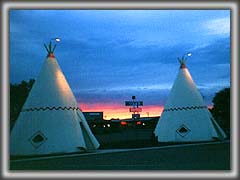 Another Stereotype of the Month entry:
Another Stereotype of the Month entry: Another Stereotype of the Month entry:
Another Stereotype of the Month entry:
Quirky motel offers chance to sleep in a 'wigwam'
Alisa Blackwood
Associated Press Oct. 22, 2001 09:35:00
HOLBROOK -- There probably isn't a kid in the country who wouldn't jump at the chance to sleep in a giant teepee, even if it's a concrete imitation serving as a quirky motel room.
And admittedly, there are plenty of adults -- with or without kids -- drawn to the romance of the Old West and Historic Route 66 who'd rather bunk up at the Wigwam Motel than yet another chain motel.
"When you drive up and see the place, it gives you the giggles. And when you're inside, you're actually in the shape of a teepee. ... It's just pure fun," said Patty Gegenheimer, a guest from Truckee, Calif. who recently stayed at the motel.
The bright, white, cone-shaped structures with red zigzag designs stand tall against Arizona's wide-open desert sky. It's a throwback to 1950s kitsch and a time when family road trips every summer were the norm.
Whether you've read about the Wigwam Motel in a travel guidebook or happened upon it while cruising along Historic Route 66, may roadtrippers can't seem to resist the chance to stay here.
A sign at the motel's entrance asks, "Have you slept in a wigwam lately?"
More than likely, the answer is no -- especially because a wigwam is a kind of traditional American Indian home that is actually dome-shaped, not teepee-shaped. But that makes no difference to roadtrippers. You couldn't get this much personality in a regular motel.
The motel opened in the summer of 1950 and aside for some repainting and dusting, has remained exactly the same, down to the original log pole furniture and American Indian decor inside each room, said John Lewis, whose father, Chester E. Lewis, built the motel.
Classic cars in near perfect condition are parked in front of the 16 teepees, which are arranged in a semicircle facing what's now called Hopi Road.
"It gives you a chance to reminisce on what it was like to travel back in the 1950s and 1960s," Gegenheimer said.
Surprisingly, this roadside oddity isn't the only one of it's kind.
The Wigwam Motel in Holbrook was the sixth of seven teepee motels known as Wigwam Villages built across the country.
John Redford built the first Wigwam Village in Horse Cave, Ky. and patented his idea in 1936. When Chester Lewis saw the motel, he tracked down Redford and bought the plans and blueprints from him for his own motel in Holbrook.
The other five motels sprang up in New Orleans, Orlando, Fla.; Birmingham, Ala.; Rialto, Calif. and Cave City, Ky. Only the motels in Cave City, Rialto and Holbrook are still open.
After Interstate 40 bypassed Route 66 in Holbrook, traffic through the small town significantly decreased and the Wigwam Motel closed in 1974. Chester Lewis died in 1986.
The family, which operates the motel out of love for the place, renovated and reopened it in 1988. A night's stay at the Wigwam costs about $40.
"We felt it was our obligation to reopen it to the public," said Lewis, who runs the motel with his sister, Elinor Lewis.
Time and time again, Lewis has welcomed adult guests who have waited their whole lives to sleep in one of his teepee rooms.
"Almost every other evening they come by and say their parents would not let them stay in a wigwam 35 or 40 years ago," he said. "As I walk them through their experience as children they remember throwing temper tantrums about not being able to stay there.
"It's kind of a therapeutic thing for them. Some of them get quite emotional."
German tourist Peter Stracke has stayed at the Wigwam Motel twice a year for the last decade while shopping for American Indian arts and crafts to fill his store back home, Gallery Kokopelli.
"It's unique. It's a great piece of American heritage," Stracke said. "It's like traveling back in time in a way."
And if you're looking for individuality, you'll be hard pressed to find accommodations more original than the Wigwam Motel. It hardly makes a difference that the motel doesn't have a few of the usual amenities we've come to expect. You'll have to bring your own shampoo, soap and clock.
"You don't always need to have ... all the accouterments, the hairdryers, the coffee makers, that go along with middle America motels," said Gegenheimer, who was staying at the Wigwam Motel for the second time. "We just had to stay there. They are too enticing. The place just has a charm."
—-
On the Net:
Wigwam Motel, Holbrook, Ariz.: http://www.nephi.com/wigwam-motel.htm
Wigwam Village, Cave City, Ky.: http://www.wigwamvillage.com/
Rob's comment
Not only didn't Indians west of the Mississippi live in wigwams, but the Indians of the Southwest—where this motel is located—didn't live in tipis either. The Hopi (as in Hopi Road) live in pueblos, not tipis or wigwams.
|
. . . |

|
All material © copyright its original owners, except where noted.
Original text and pictures © copyright 2007 by Robert Schmidt.
Copyrighted material is posted under the Fair Use provision of the Copyright Act,
which allows copying for nonprofit educational uses including criticism and commentary.
Comments sent to the publisher become the property of Blue Corn Comics
and may be used in other postings without permission.